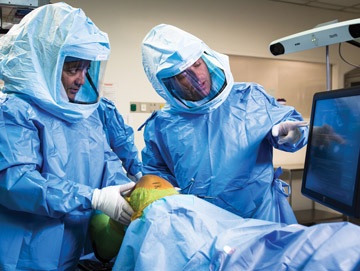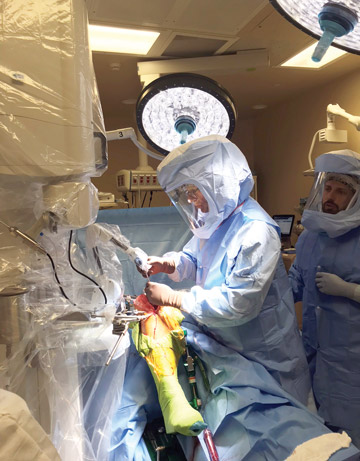What if your surgeons had the ability to perform the perfect knee replacement, limiting against soft tissue damage and ensuring they had the right bone cut every time? That’s the hope of the latest robotic systems that increasing numbers of orthopedic surgeons are using for total and partial knee replacements. Surgeons who rely on robotic assistance love to share why they love the technology, and how patients and facilities are benefiting from it.
“A knee can be replaced without a robot, but the technology prevents outliers,” says Brian Patrick Flanagan, MD, an orthopedic surgeon at Northwestern Medicine Huntley (Ill.) Hospital. “Those rare cases where ligaments are too tight or implants aren’t aligned, or a muscle gets injured because the saw slips out of the bone — that’s all prevented with the robot.”
More manufacturers are creating robotic orthopedic systems, and each have different capabilities and work with different implants, says Yair D. Kissin, MD, FAAOS, vice chairman of the department of orthopedic surgery at Hackensack (N.J.) University Medical Center. Haptic systems, which were the first robots available to orthopedic surgeons for knee replacement procedures, use 3D models of patients’ specific joint anatomy that are created from pre-op CT scans. The systems feature a robotic arm with an attached saw that provides feedback to surgeons as they cut, ensuring the saw doesn’t leave the intended path.
Dr. Flanagan says his haptic robotic system ensures he’s getting the right cut and placement of the implant each time, allowing him to shift the implant placement a tenth of a millimeter at a time, or rotate the implant placement just a degree or two for the perfect fit. The system can be used for both partial and total knee replacements.
One of the key benefits of a haptic system is that the robot has boundaries that prevent you from sawing outside of the bone area, points out Dr. Flanagan. “Even if you try to push it into a ligament or soft tissue, it will stop it,” he says.
While haptic systems still require surgeons to do some of the manual labor, a new robotic system removes them entirely from the cutting process. These systems still use a 3D model created by pre-op scans of the patient’s joint, but instead of the surgeon operating the robotic arm, the active robotic system makes the cuts to the bone while the surgeon stands by with a hand-held controller, says Dr. Kissin. Because the technology is so new, this robot can currently be used only for total knee replacements.
“The main difference is that you’re removing the potential for human error,” says Dr. Kissin, who was the first in the nation to perform surgery with the robot this year. “Surgeons still set up cases similar to how they would with a haptic system. However, when it’s time to cut, the robot will go in and do it.”
.svg?sfvrsn=be606e78_3)


.svg?sfvrsn=56b2f850_5)